Usually, filariasis appears in children of preschool and primary school age. Where do worms come from? The main cause of worm infestation in children is improper hygiene. Young children don't always wash their hands, they like to put their fingers in their mouths, bite their nails and eat unwashed vegetables. The development of helminthic invasion occurs if a person has weakened immunity. The immune system in children is newly formed, not yet able to cope with a large number of foreign agents. Signs of worm infection in children are similar to symptoms of poisoning or diseases of the gastrointestinal tract.
Why are worms dangerous for a child's body? They damage internal organs, suck up nutrients, cause inflammation. Toxins that worms secrete adversely affect the baby's nervous system. You can deworm with the help of traditional and oriental medicine.
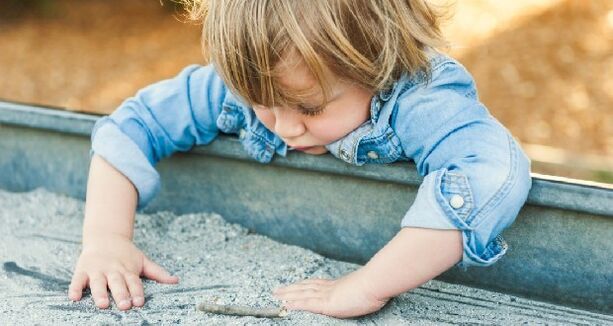
Types of worms in children
Helminthiasis in children appears quite often, especially in preschool age. The risk of infection is always high. A child can get an infection in daycare, on the playground, in contact with animals. In addition, children often do not wash their hands after going to the toilet, before eating.
What is worm? Worms are a very large group of parasitic worms. They can live in the intestines, liver, respiratory tract, and some can affect the heart and brain. The main types of worms in children:
- Roundworms - the most common parasites in humans, including pinworms, roundworms, hookworms, trichinella.
- Tapeworms - the class includes beef tapeworms and pork tapeworms (tapeworms), echinococcus.
- Tapeworms are hereditary flukes, they include schistosomes, opisthorchis, flukes (liver and cats).
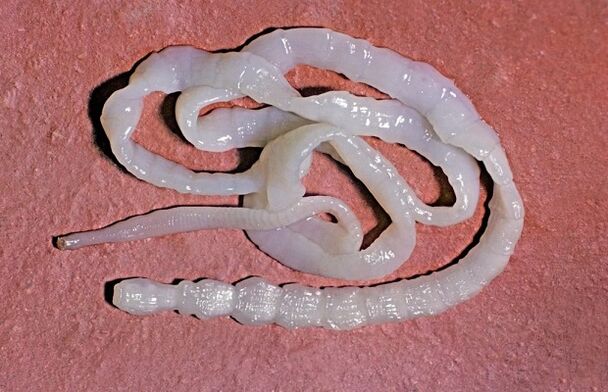
In addition, parasitic diseases are caused by protozoa - protozoa, in the human intestine, Giardia or parasitic amoeba.
Parasitic diseases in children have different levels of danger, but all have the same symptoms. The vast majority of roundworms are parasitic in the gastrointestinal tract, in the duodenum, in the feces. The source of nutrition for worms is digested food (most commonly carbohydrates), sometimes blood. Helminthiases in children have symptoms similar to those of an eating disorder or gastrointestinal illness.
The most common types of helminths in children
Children are much more susceptible to worm infections than adults. The most common types of helminths in children:
- Enterobiasis (pinworm infection).
- Roundworm (ringworm infestation).
- Giardiasis (giardia infiltration).
Pinworms live only in the intestines. Roundworm larvae migrate into the respiratory tract, liver and heart. Giardia very often cause diseases of the liver and gallbladder, although they cannot survive inside these organs. Are these diseases contagious?
Heartworm disease is transmitted from person to person by shaking hands, touching objects in the house used by an infected person.
Ringworm and giardiasis, under certain conditions, can also be passed from a baby to other family members.

Enterobiasis
The main cause of pinworm infection is dirty hands. In addition, parasite eggs can enter the child's body when eating unwashed fruit. Signs of worm infection will appear after 3-4 weeks from the date of infection. The characteristic sign of filariasis is itching in the anal area, which occurs during sleep. The discomfort is caused by the female worm moving, crawling out to lay eggs. With strong penetration, you can see the worms in the child's stool with the naked eye.
When children scratch their anus, then put their hands in their mouth (this is often the case with young children), reinfection will occur. Therefore, during the treatment of helminths, it is necessary to monitor children so that they often wash their hands and eat only foods that have been carefully processed.
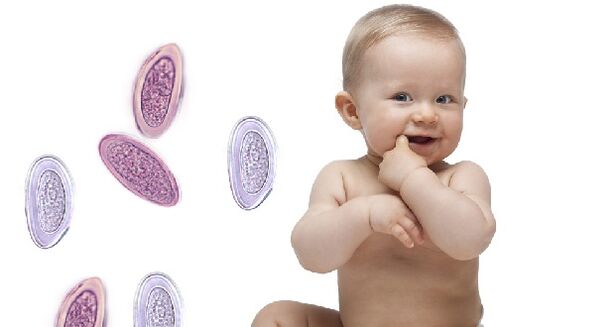
Roundworm disease
Roundworm infection occurs through unwashed produce, undercooked meat, and through contact with animals. Parasites enter the baby's body in the form of eggs and larvae. Eggs develop in the intestine, larvae begin to migrate through the bloodstream and lymphatic channels. They reach the liver, the right ventricle of the heart, the lungs. These organs are regularly and abundantly supplied with oxygen, which is essential for the larvae to develop into adults. From the lungs, larvae will enter the bronchi, trachea, cough up saliva and be swallowed with saliva into the stomach. The cycle of movements continues until the larvae develop.
With worm disease in children, in addition to the typical symptoms may appear a violent cough. Trichinosis in children is detected using transcriptome and specific blood tests.

Giardiasis
Giardiasis in children develops when more than 10 cysts enter the body. The cyst is immobile, resistant to environmental conditions, the form of lamblia exists, from which favorable conditions are met for individuals capable of reproduction. Protozoa can only live in conditions created only in the human small intestine.
Stages of development of Giardia invasive in humans:
- Cysts from the oral cavity pass into the stomach, and then into the duodenum. The protective capsule is destroyed, the two Giardia are released.
- Giardia eat simple carbohydrates, which multiply by dividing the cell vertically in half.
- Part of the parasites enter the large intestine, where they can only exist as cysts.
- During defecation, the cysts will prolapse and go to the outside environment.
Giardia cysts can be found in water, vegetables, fruits, meat, and household surfaces. They are very tenacious, they are difficult to destroy with ordinary cleaning agents. The risk of person-to-person transmission is low.
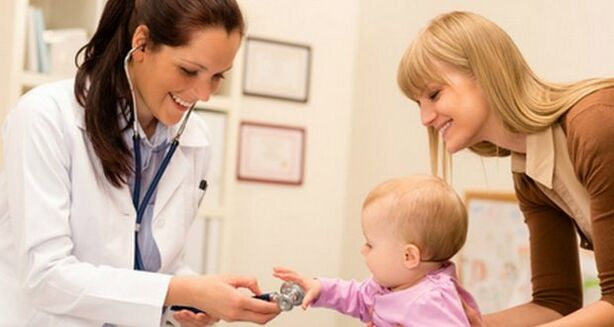
Typical symptoms of helminthiasis in children
The first signs of worms appear 2-4 weeks after infection. Infection in children can be acute or latent. If the parasite population is low, the baby may not feel any discomfort.
The main symptoms of worms in children:
- Pain in the abdomen with different localization and intensity, manifested by convulsions.
- Stool disturbances, diarrhea and constipation.
- Nausea vomiting.
- Decreased or, conversely, brutal appetite.
- Intestinal infections.
- Loss of strength, dizziness.
- Sleep disorders.
- Inflammation of the skin.
- Pale skin, dark circles under the eyes.
- Girls can have urinary incontinence.
Dermatitis (rash, redness, itching of the skin) is the result of an allergic reaction to the toxins secreted by the worms. Harmful substances also affect the state of the nervous system. Children look tired, become irritable, capricious.
Acute infection is accompanied by the symptoms of helminthiasis in children - fever, vomiting, diarrhea.
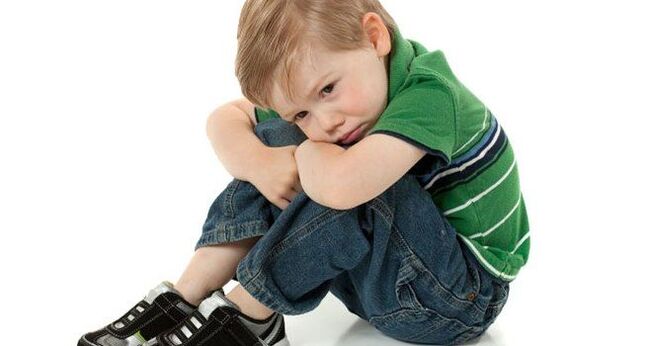
Test for worms in children
How to identify worms in a child? The status of worm infection in children is difficult to determine by clinical presentation. The symptoms of different helminth diseases are similar. The detection of worms is done both with the help of time-tested laboratory diagnostic methods and new laboratory diagnostic methods.
- Histological analysis of stool allows you to check for the presence of helminth eggs in the stool.
- Microscopic examination of scratches from the anus (helps identify intestinal worms).
- Analysis of the contents of the duodenum. In the duodenum contents, worms or protozoa can be found.
- General blood test with white blood cell count. Indirect signs of the presence of worms are eosinophilia and anemia.
- Serum testing for antibodies to helminth antigens.
- Analysis by polymerase chain reaction (PCR).
PCR is the most sensitive and reliable method for diagnosing helminthic invasion. Blood, feces, and debris are suitable for analysis. The study determines the presence of foreign DNA in a biological sample. The efficiency of the histological synchronization program was worse than that of PCR and ELISA.
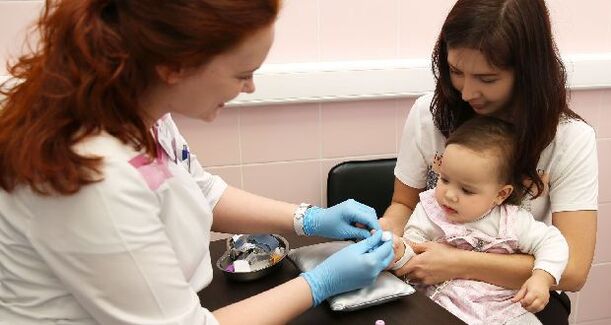
Principles of treatment of helminth invasions
How to deworm children? Treatment depends on the type and extent of infestation. Usually, helminthiasis is treated conservatively (without surgery), but surgery is performed to remove the cyst.
Treatment of worms in children includes several stages:
- Prepare your body for treatment.
- The fact is therapy, taking dewormers.
- Restoration of the body after illness and medication. It is necessary to normalize the activity of the nervous system, increase immunity, get rid of intestinal bacterial disorders.
Usually treatment takes about three months. Before proceeding with therapy, you need to correctly determine whether the child is infected with worms. The treatment is prescribed and controlled by the doctor.

Drug treatment for helminthiasis in children
An integrated method will help to completely cure all types of helminths without harming the body. You can treat worms in your child using several medications:
- Dewormer. These include antiparasitic drugs that differ in spectrum and principle of action. Indicated depending on the type of invasion. It is more convenient to give the baby the medicine in the form of a suspension.
- Absorbents. Bind toxins, accelerate the elimination of worms from the body. Only strictly defined sorbent dosages should be taken, otherwise serious gastrointestinal disturbances may occur.
- Anti-allergy medication. Helps relieve symptoms of allergies to helminthic waste products.
- Hepatoprotective drugs. Indicated during the recovery period. Helps to normalize the functioning of the liver.
- enzyme preparations. Restore normal digestion.
In the treatment of helminthiasis, the patient is also prescribed an enema. If your baby is constipated, your doctor will prescribe a laxative for your baby. It is important to provide regular stools so that parasites and toxins are eliminated from the body. It is not possible to take any medication uncontrollably, as there may be side effects.
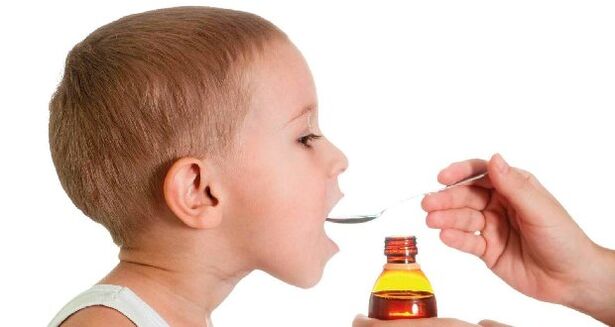
Traditional dewormer
Traditional medicine is undesirable to use to treat helminthiasis in children. They do not kill worms and do not help remove them from the body. Folk remedies are applied only in combination with drug treatment.
Deworming children by folk methods like? There are some of the most popular recipes:
- Pumpkin seeds. Contains ingredients that interfere with the normal functioning of worms, eliminating toxins. Shelled seeds (100 g) are crushed and poured with olive oil (100 ml). Alcohol is given to the child before meals (three hours) for three days. The treatment is repeated after 2 days. Pumpkin seeds can be boiled in milk (15 seeds in 1 glass). The remedy is given to the baby to drink before lunch.
- Garlic mixture. A few cloves of garlic (2-3) must be grinded on a fine grinder, mixed with a small amount of water until smooth. For young children, crushed garlic is mixed with a spoonful of milk or orange juice, given before bedtime.
- Onions in oil. 100 grams of chopped dried onions, covered with a teaspoon of salt, pour with 50 ml of sunflower or olive oil. This mixture is given to the baby for 5 consecutive days before bedtime.

Beet juice - carrot, tincture of wild chrysanthemums will help increase the child's immunity. Restores the nervous system - chamomile tea. Chamomile is also used to douche for helminths.
Folk remedies are contraindicated in children with peptic ulcers, gastritis, pancreatitis, with a predisposition to allergies. And, of course, before you start testing "grandmother's recipes" for a child, first consult a pediatrician and parasitologist, otherwise, the results ofThat therapy can be the most unpredictable.
Functional foods and homeopathy for worms
The internet is flooded with advertisements for bioactive additives (BAAs) and homeopathic remedies that, according to the manufacturers, will get rid of the worms completely. Reviews of the fund are extremely positive.
Why can't functional foods be used to treat worms for children? The biologically active dietary supplement helps to normalize metabolism, increase the body's resistance, improve the functioning of internal organs, but does not eliminate parasites. They can only be used in combination with traditional medicines.
Homeopathic preparations include a complex of natural extracts. They also have no adverse effects on worms. But they can increase immunity, restore metabolism. In many countries today it is forbidden to prescribe homeopathic medicines because they are not effective.
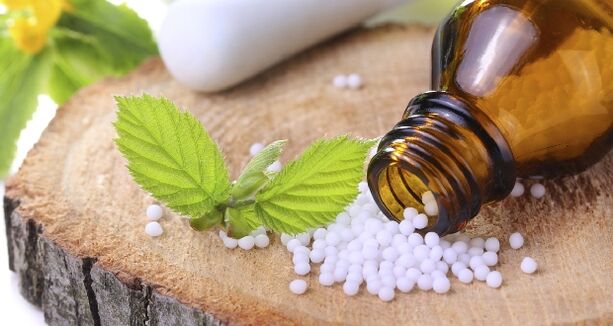
Prevention of helminths in children
Prevention of the occurrence of helminthiasis in children includes simple measures:
- Toilet. Parents need to ensure that children often wash their hands, take baths, do not bite their nails, do not put toys in their mouths.
- Sufficient heat treatment for meat and fish.
- Shave regularly to look for enterobiosis bacteria (this is done in kindergarten).
- Healthy sleep, adhere to daily routines.
- Balancing diet.
- Take vitamins.
Prophylaxis with medication should be done if infections are reported at the nursery or school, one of the household members or pets has been infected.
The symptoms of helminthiasis in children are easily confused with the manifestations of food poisoning and diseases of the gastrointestinal tract. How to find out if a child has a worm infection, the doctor will tell you. Children can be treated for deworming after an accurate diagnosis under the close supervision of a specialist. Concerned parents should understand that the health of their young children is entirely in their hands.






































